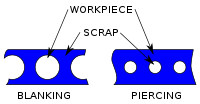
Photo from wikipedia
Abstract The shear punch test (SPT) is a suitable experiment for characterizing the shear behavior of various materials, especially where there are volume limitations. In the present investigation, the relations… Click to show full abstract
Abstract The shear punch test (SPT) is a suitable experiment for characterizing the shear behavior of various materials, especially where there are volume limitations. In the present investigation, the relations among various parameters such as clearance, die diameter and sample thickness, and the yield and ultimate shear strengths of AZ80 Mg alloy were studied. Moreover, based on the Mohr−Coulomb theory, relatively optimum conditions were introduced for the shear punch test. With this regard, a range of 2%−10% is found to be suitable for the clearance/sheet thickness ratio. To provide a simple shear stress state during a shear punch test, it is also necessary to select the die diameter/sheet thickness ratio between 2:1 and 10:1. Based on the predictions of the Mohr−Coulomb theory, it is better to conduct a room-temperature shear punch test with a sample thickness of 0.5 mm, a clearance of 25 µm and a die diameter of 2 mm. Finally, the mean conversion factors to gain the tensile and compressive yield strengths of the cast AZ80 from its shear one are found to be 1.70 and 3.09, respectively.
Journal Title: Transactions of Nonferrous Metals Society of China
Year Published: 2018
Link to full text (if available)
Share on Social Media: Sign Up to like & get
recommendations!